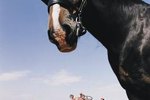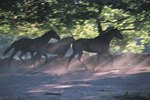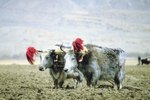During the 19th century, cattle ranches spread from Mexico up through Texas and then across the United States. Between 1800 and 1900, cattle population rose and raising cattle became a profitable industry. Reaching its peak from 1867 through 1880, the cattle industry underwent a number of changes. It was eventually brought down by severe winter weather and falling demand for beef.
Origin of Cattle Ranches
Cattle were brought to America by European settlers in the late 1400s. Free-roaming cattle ranches were popular in Mexico during the early 1800s, and when Texas separated from Mexico in 1836, the cattle remained in the state which is today known as Texas. The cattle industry was relatively small at the time, as meat preservation was difficult, so cattle were mainly used for their tallow and their hides. During the Civil War, cattle ranches were abandoned while soldiers went off to fight, but the cattle continued to multiply. Longhorn cattle numbered 5 million by 1865, but their population was concentrated in Texas, where there was little market for the animals.
Cattle Drives
Cattle drives originated around 1866, as ranchers needed to move their cattle to areas where the demand was greater and the animals would bring higher prices. Cattle were still free-roaming at this point, meaning that ranchers did not use fencing to separate their herds. Herds were identified by brands applied to the animals' flanks, marking them as the property of the particular ranch. Cattle drives began in the spring after the ground had thawed. A herd boss in charge of the operation, along with a crew of cowboys on horseback, would herd the cows on routes which frequently stretched from Texas all the way to Kansas.
The Beef Bonanza
Although there was little demand for cattle in Texas, the demand in the East meant that moving cattle could become a profitable investment. Joseph McCoy, a livestock trader, built a livestock yard in Abilene and then herded huge numbers of cattle there. From there they could be moved further east by railway, where they could be sold for higher prices. The advancement of the railway, including the creation of refrigerated rail carriages, facilitated cattle transportation and made it more cost-effective, leading to the movement which was known as "the Beef Bonanza."
The Winter of Death
The thriving cattle industry faced numerous obstacles which brought about the end of many ranches. The invention of barbed wire in 1874 meant that more ranches kept their cattle confined to smaller areas, which led to overgrazing. Additionally, the summer of 1886 was hot and dry, destroying much of the grazing available to the cattle. The following winter, referred to as the “Winter of Death,” was harsh enough to freeze more than half of the cattle population in the American West. Accompanied by less demand for beef, this disaster caused cattle investors to go bankrupt after losing their herds, and cattle ranches to close down, leaving ranchers and cowboys unemployed.
References
Photo Credits
-
Jupiterimages/Photos.com/Getty Images
Writer Bio
Paige Cerulli has been writing since 2005. She has published articles for "Horse Family Magazine" and "Valley Animals." Cerulli has experience in writing about music and animals. Cerulli graduated from Westfield State College with a Bachelor of Arts in English and Music.





